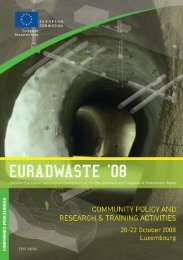EU industrial structure - EU Bookshop - Europa
EU industrial structure - EU Bookshop - Europa
EU industrial structure - EU Bookshop - Europa
You also want an ePaper? Increase the reach of your titles
YUMPU automatically turns print PDFs into web optimized ePapers that Google loves.
<strong>EU</strong> <strong>industrial</strong> <strong>structure</strong> 2011 — Trends and Performance<br />
sectors except textiles, paper, machinery n.e.c, electrical<br />
equipment and basic metals, half or more of <strong>EU</strong>‑27 exports<br />
are destined for high income countries.<br />
Part of international trade consists of cross‑border flows<br />
of products of different industries (inter‑industry trade)<br />
reflecting relative different factor (labour and capital)<br />
endowments and technology. Countries which are relatively<br />
endowed with capital tend to trade capital intensive goods<br />
in exchange for labour intensive goods from countries<br />
which are relatively well endowed with labour: for example,<br />
pharmaceuticals for textiles or motor cars for food.<br />
However, there is a high share of exchange of similar goods<br />
between countries, with comparable levels of income. High<br />
income countries tend for example to trade different brands<br />
of cars with each other and low income countries different<br />
types of clothes for each other. This intra‑industry trade<br />
(IIT) is explained by factors such as economies of scale and<br />
demand for differentiated products, rather than by relative<br />
factor endowments. As demand for differentiated products,<br />
and varieties of different qualities, tend to rise with income,<br />
per capita incomes of countries play an important role in<br />
determining trade patterns.<br />
Almost 54 % of world trade occurs between countries in<br />
the groups composed of the <strong>EU</strong>‑27 and other high‑income<br />
countries. If upper‑medium countries are included, this<br />
share rises to 70 %.<br />
China stands out in the group of BRIC countries (Brazil,<br />
Russia, India, China). More than 40 % of <strong>EU</strong> imports<br />
in furniture, leather and footwear, clothing, electrical<br />
equipment, non‑metallic mineral products, and metal<br />
products come from China. Brazil captures 14 % and 12 % of<br />
<strong>EU</strong> imports of paper and food products.<br />
Competitiveness on world markets is measured by indices<br />
of revealed comparative advantages. The measurements<br />
of revealed comparative advantages for manufacturing<br />
in 2009 show that the <strong>EU</strong>‑27 had comparative advantages<br />
in industries such as printing, beverages, tobacco products,<br />
motor vehicles and pharmaceuticals. In contrast, the<br />
<strong>EU</strong>‑27 did not have any comparative advantages in<br />
the production of computers, electronic and optical<br />
products, textiles, other manufacturing, clothing and<br />
refined petroleum. The measure of revealed comparative<br />
advantages has some weaknesses which should be<br />
taken into account. It is sensitive for the level of sectoral<br />
aggregation, which may mask differing performance in<br />
various categories of goods within the same group of<br />
products. This is particularly relevant for industries which<br />
10<br />
have a large variety of brands and quality levels for the<br />
same type of goods. Another consideration is country<br />
heterogeneity within the <strong>EU</strong>, as the performance of the <strong>EU</strong><br />
as a whole is explained in some cases by the performance<br />
of a few <strong>EU</strong> countries. Finally, the weight of each sector and<br />
country in the export <strong>structure</strong> of the <strong>EU</strong> should be borne<br />
in mind to get to a balanced assessment of the <strong>EU</strong>’s sectoral<br />
performance in external trade.<br />
Analysing comparative advantages for individual Member<br />
States reveals that many <strong>EU</strong> countries, in 2009, have<br />
comparative advantages in the production of wood and<br />
wood products. The high revealed comparative advantages<br />
for Austria, Estonia, Finland, Latvia and Portugal are in line<br />
with the specialisation patterns that could be observed in<br />
the analyses of <strong>industrial</strong> <strong>structure</strong>. Belgium, Cyprus and<br />
Ireland appear to have comparative advantages in basic<br />
pharmaceutical products. Bulgaria, Greece, Portugal and<br />
Romania have comparative advantages in clothing and<br />
Italy, Portugal and Romania have comparative advantages<br />
in leather and footwear.<br />
US manufacturing industries have comparative advantages<br />
in chemicals, pharmaceuticals, machinery and other<br />
manufacturing goods. Japanese manufacturing industries<br />
have comparative advantages in motor vehicles, other<br />
transport equipment, machinery, computers, electronic<br />
and optical products. Analyses of the BRIC countries show<br />
that the Brazilian, Indian and Russian manufacturing<br />
industries have comparative advantages in the production<br />
of labour intensive goods or products which are based on<br />
endowments of natural resources. Chinese manufacturing<br />
industries display a different pattern. It may seem as if China<br />
has become one of the most important trade partners<br />
in high technology goods but the high comparative<br />
advantage of China in this type of trade should be<br />
taken with a pinch of salt. China exports proportionally<br />
more technology‑intensive goods, but a large share of<br />
the content is imported from developed countries. As<br />
confirmed by data on trade in intermediate goods, China is<br />
still more an ‘assembler’ than a producer of high technology<br />
goods. While the Chinese import of intermediate goods<br />
consists of high quality goods, their exports seem to be of<br />
a lower quality.<br />
The analyses of trade in service show that the <strong>EU</strong>,<br />
in 2009, has comparative advantages in almost all sectors<br />
except personal, cultural and recreational, construction<br />
services and travel. 1 Cyprus, Luxembourg and the<br />
UK has comparative advantages in financial services.<br />
1 See Chapter IV for a definition of these types of services.
















